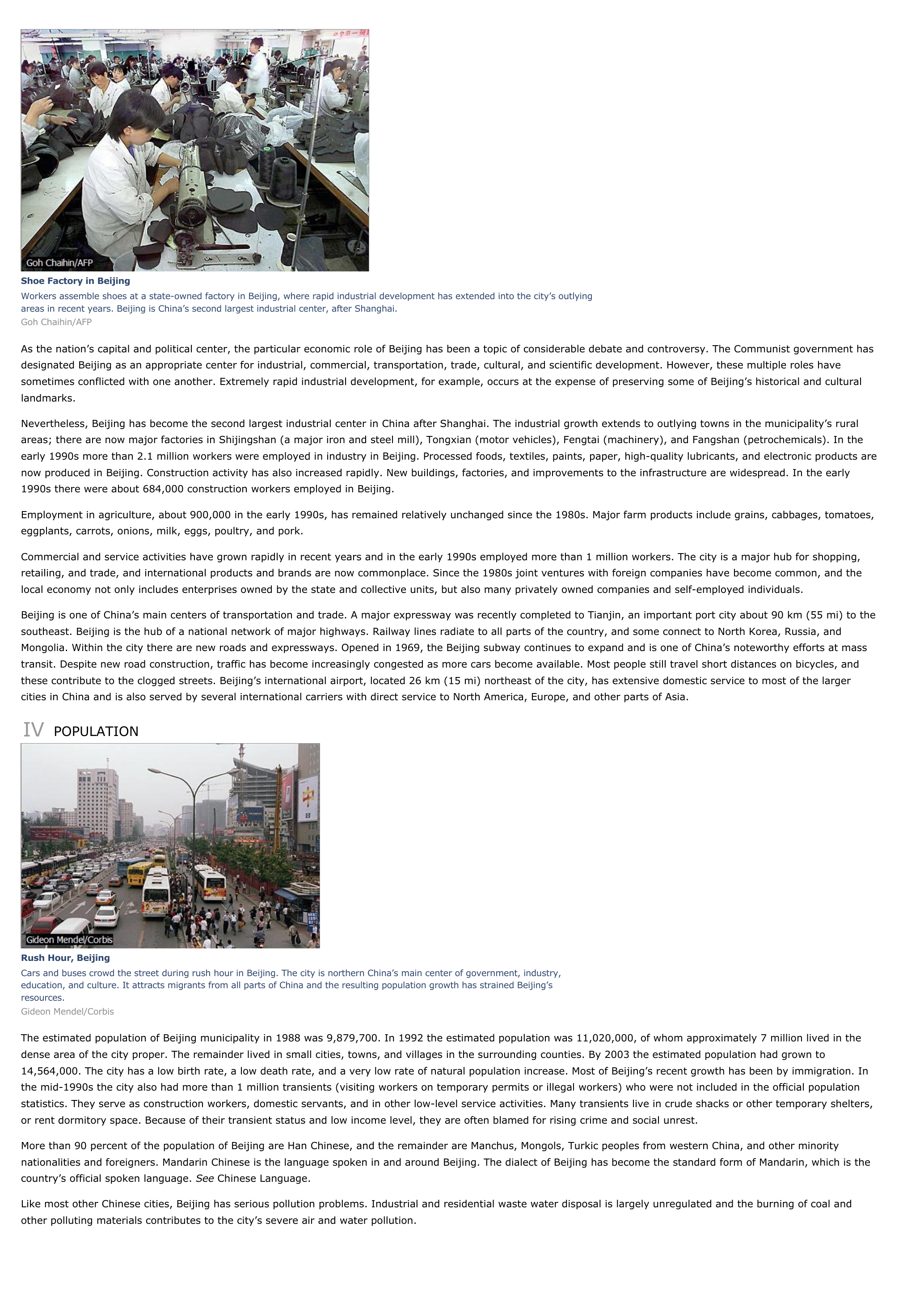Beijing - geography.
Publié le 27/05/2013

Extrait du document
«
Shoe Factory in BeijingWorkers assemble shoes at a state-owned factory in Beijing, where rapid industrial development has extended into the city’s outlyingareas in recent years.
Beijing is China’s second largest industrial center, after Shanghai.Goh Chaihin/AFP
As the nation’s capital and political center, the particular economic role of Beijing has been a topic of considerable debate and controversy.
The Communist government hasdesignated Beijing as an appropriate center for industrial, commercial, transportation, trade, cultural, and scientific development.
However, these multiple roles havesometimes conflicted with one another.
Extremely rapid industrial development, for example, occurs at the expense of preserving some of Beijing’s historical and culturallandmarks.
Nevertheless, Beijing has become the second largest industrial center in China after Shanghai.
The industrial growth extends to outlying towns in the municipality’s ruralareas; there are now major factories in Shijingshan (a major iron and steel mill), Tongxian (motor vehicles), Fengtai (machinery), and Fangshan (petrochemicals).
In theearly 1990s more than 2.1 million workers were employed in industry in Beijing.
Processed foods, textiles, paints, paper, high-quality lubricants, and electronic products arenow produced in Beijing.
Construction activity has also increased rapidly.
New buildings, factories, and improvements to the infrastructure are widespread.
In the early1990s there were about 684,000 construction workers employed in Beijing.
Employment in agriculture, about 900,000 in the early 1990s, has remained relatively unchanged since the 1980s.
Major farm products include grains, cabbages, tomatoes,eggplants, carrots, onions, milk, eggs, poultry, and pork.
Commercial and service activities have grown rapidly in recent years and in the early 1990s employed more than 1 million workers.
The city is a major hub for shopping,retailing, and trade, and international products and brands are now commonplace.
Since the 1980s joint ventures with foreign companies have become common, and thelocal economy not only includes enterprises owned by the state and collective units, but also many privately owned companies and self-employed individuals.
Beijing is one of China’s main centers of transportation and trade.
A major expressway was recently completed to Tianjin, an important port city about 90 km (55 mi) to thesoutheast.
Beijing is the hub of a national network of major highways.
Railway lines radiate to all parts of the country, and some connect to North Korea, Russia, andMongolia.
Within the city there are new roads and expressways.
Opened in 1969, the Beijing subway continues to expand and is one of China’s noteworthy efforts at masstransit.
Despite new road construction, traffic has become increasingly congested as more cars become available.
Most people still travel short distances on bicycles, andthese contribute to the clogged streets.
Beijing’s international airport, located 26 km (15 mi) northeast of the city, has extensive domestic service to most of the largercities in China and is also served by several international carriers with direct service to North America, Europe, and other parts of Asia.
IV POPULATION
Rush Hour, BeijingCars and buses crowd the street during rush hour in Beijing.
The city is northern China’s main center of government, industry,education, and culture.
It attracts migrants from all parts of China and the resulting population growth has strained Beijing’sresources.Gideon Mendel/Corbis
The estimated population of Beijing municipality in 1988 was 9,879,700.
In 1992 the estimated population was 11,020,000, of whom approximately 7 million lived in thedense area of the city proper.
The remainder lived in small cities, towns, and villages in the surrounding counties.
By 2003 the estimated population had grown to14,564,000.
The city has a low birth rate, a low death rate, and a very low rate of natural population increase.
Most of Beijing’s recent growth has been by immigration.
Inthe mid-1990s the city also had more than 1 million transients (visiting workers on temporary permits or illegal workers) who were not included in the official populationstatistics.
They serve as construction workers, domestic servants, and in other low-level service activities.
Many transients live in crude shacks or other temporary shelters,or rent dormitory space.
Because of their transient status and low income level, they are often blamed for rising crime and social unrest.
More than 90 percent of the population of Beijing are Han Chinese, and the remainder are Manchus, Mongols, Turkic peoples from western China, and other minoritynationalities and foreigners.
Mandarin Chinese is the language spoken in and around Beijing.
The dialect of Beijing has become the standard form of Mandarin, which is thecountry’s official spoken language.
See Chinese Language.
Like most other Chinese cities, Beijing has serious pollution problems.
Industrial and residential waste water disposal is largely unregulated and the burning of coal andother polluting materials contributes to the city’s severe air and water pollution..
»
↓↓↓ APERÇU DU DOCUMENT ↓↓↓
Liens utiles
- Beijing - geography.
- How Beijing deals with pollution and global warming ?
- Pékin, en pinyin Beijing (« capitale du Nord »), capitale de la République populaire de Chine, au nord de la plaine centrale chinoise, et à 140 km de la mer Jaune (golfe de Bohai).
- Tokyo - geography.
- Toronto - geography.

































